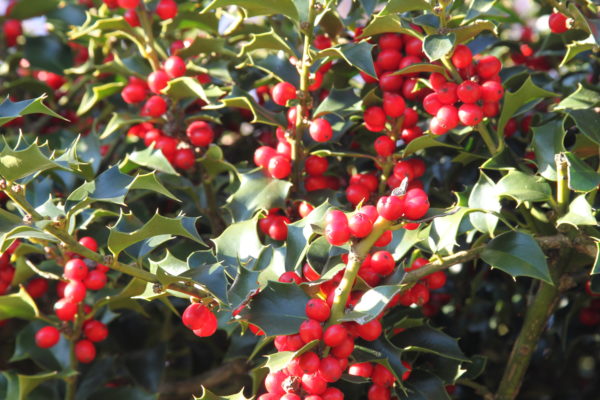I’m an evergreen shrub that can grow really tall,
and my leaves stay on through winter and fall.
I’m used for sharing holiday cheer,
while sneakily spreading all over the sphere.

Photo credit: Nature Hills Nursery
I Spy in the Sea to Sky…
This plant is native to the British Isles as well as southern and central Europe. It has bright red berries and is commonly used as a Christmas ornament! It can also live up to 250 years. Can you guess what it is?
It’s English holly (ilex aquifolium)! It flowers in March and April and produces berries from November to February. English holly tolerates a wide range of soil, moisture, temperature and light conditions, and is often found in deciduous forests, wetlands, and near residential areas. English holly is abundant in certain portions of the Sea to Sky region (i.e., in Squamish and south), but has not yet infested all potential habitats. The goal is to contain the spread of English holly to ISMA 1.

photo credit: macywho, iNaturalist
English holly can be easily identified by several distinctive features:
- Dark green, glossy leaves. Young leaves have stiff, sharp spines on leaf margins, while mature leaves have smooth leaf margins and fewer spines, if any.
- The leaves grow in an alternate pattern up the stem. (So a single leaf will grow on one side, then further up the stem another leaf will emerge.)
- Small, white, inconspicuous flowers that smell slightly sweet.
- An erect stem with spreading branches. Young plants have green bark, while mature plants have grey-silver bark.
- A long, woody root.
Does English holly have any lookalikes?
There are a couple of species that may be confused with English holly:

Oregon grape is a native evergreen shrub with a similar leaf shape. However, one key difference is Oregon grape leaves are arranged opposite each other along the stem, while English holly leaves are arranged alternately along the stem. Oregon grape also has blue-purple berries that resemble small grapes, while English holly produces bright red berries.

San Jose Holly (Ilex x aquipernyi ‘San Jose’) closely resembles English Holly, without its invasive tendencies. Both hollies have very similar leaf shapes and berries, but the San Jose variety tends to grow a bit taller than English Holly (up to 6 m tall).
Why is English holly such a concern in the Sea to Sky?
English holly poses a concern due to its aggressive spread. It reproduces both by seed and vegetatively. One shrub can produce up to 120,000 seeds annually, allowing it to proliferate rapidly.
Although pretty, the berries of English holly are poisonous to humans and pets. Additionally, English holly has several negative environmental impacts:
- It forms dense monocultures that displace native plants and lower biodiversity.
- Its roots hog nutrients and water, and modify soil conditions by adding a significant amount of organic matter and sulphur, preventing other plants from growing nearby.
- Finally, its leaves are flammable and pose a fire risk.
Please report any sightings of English holly in the Sea to Sky.






Add Comment